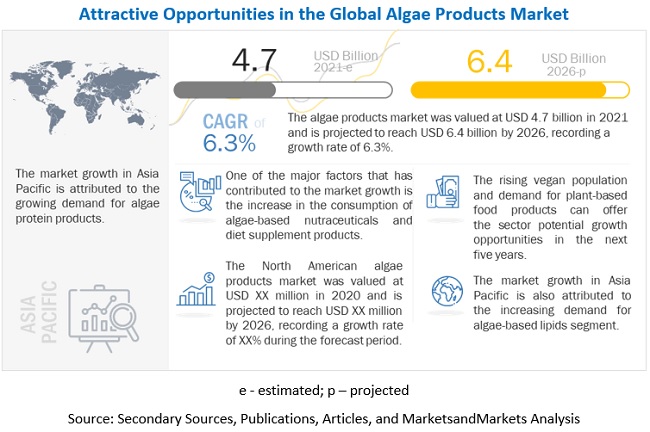According to MarketsandMarkets, the global algae products market size is estimated to be valued at USD 4.7 billion in 2021 and projected to reach USD 6.4 billion by 2026, recording a CAGR of 6.3% during the forecast period.
Algae are a diverse and large group of photosynthetic organisms that include unicellular as well as multicellular forms. Algae are polyphyletic, and most of them are aquatic. Products such as lipids (omega-3, omega-6, and omega-9), carotenoids, carrageenan, agar, algal protein, algal flour, and alginate are extracted from algae to serve various end-use applications. Algae are highly diversified in their properties, which makes them useful in applications such as food & beverages, personal care products, pharmaceuticals, animal feed, pet food, and nutraceuticals & dietary supplements.
Download PDF brochure: https://www.marketsandmarkets.com/pdfdownloadNew.asp?id=250538721

In terms of geographical coverage, the algae products market has been segmented into five regions, namely, North America, Asia Pacific, Europe, South America and Rest of the World which includes Africa and the Middle East. The Asia Pacific market is expected to witness the highest growth rate during the forecast period. China, Japan, and India are expected to contribute to the growth of the algae products market since these countries are inclining toward the use of fortified food and personal care products. Countries such as Japan and Korea use macroalgae (seaweed) as a conventional vegetable crop. The well-established market for convenience foods in China offers scope for algae products to flourish in the Asia Pacific region.
The solid form segment in the algae products market is projected to have a larger market size during the forecast period. Due to its easy handling and storage, this segment has witnessed higher demand. However, the liquid segment is projected to progress at a higher CAGR than solid. Liquid ingredients do not require binders, lubricants, fillers, buffers, or animal- or vegetable-based sheathing agents (when they are processed by end-user companies).
The lipids segment is projected to dominate the market by type. Lipids act as a source of energy for the human body and account for 20%–40% of dry algal weight, with a maximum of 85% in some algae. This is more than the lipid content of most terrestrial plants. This factor is encouraging many lipid manufacturing companies to opt for algae instead of conventional plants for extraction of lipids.
Make an Inquiry: https://www.marketsandmarkets.com/Enquiry_Before_BuyingNew.asp?id=250538721
